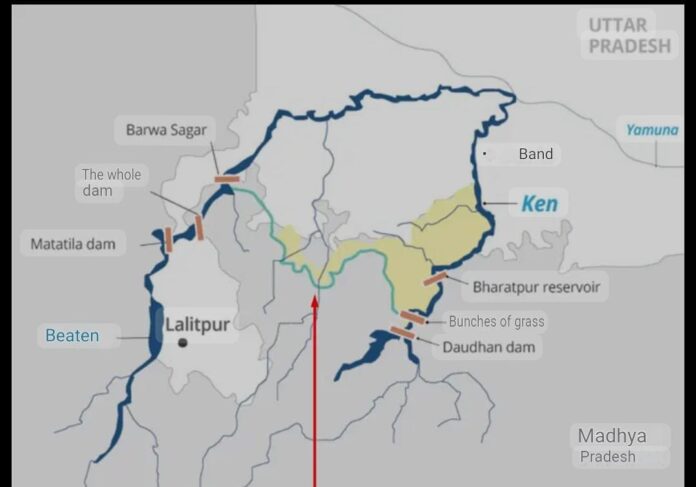A Reckless Gamble with India’s Ecology

Amit Pandey
The Modi administration’s push for the Ken-Betwa river-linking project has sparked an intense debate, exposing the conflict between economic ambitions and environmental sustainability. While the government touts the project as a solution to water scarcity in Bundelkhand, critics warn that it exemplifies the pattern of mindless development that disregards ecological concerns, scientific warnings, and social consequences. The project, which involves connecting the Ken and Betwa rivers in Madhya Pradesh and Uttar Pradesh, is being presented as a transformative initiative to alleviate drought-prone conditions in the region. However, a closer examination reveals serious flaws in its planning, execution, and justification.
At the heart of the controversy lies the devastating impact on the Panna Tiger Reserve, one of India’s most significant conservation success stories. Once declared devoid of tigers in 2009, Panna has seen a remarkable resurgence due to sustained efforts by wildlife authorities. Today, it is home to a thriving tiger population, along with critically endangered vultures and other wildlife species. The Ken-Betwa project, however, threatens to undo these efforts by submerging nearly 98 square kilometers of the reserve, displacing tigers, destroying natural corridors, and severely disrupting the region’s delicate ecological balance. Conservationists, including former Madhya Pradesh Principal Chief Conservator of Forests Jasbir Singh Chouhan, have repeatedly warned that the project will lead to irreversible damage to wildlife habitats. Yet, these concerns have been dismissed in the face of political and corporate interests.
Environmental experts have also raised alarm over the misleading rationale behind the project. Himanshu Thakkar, coordinator of the South Asia Network on Dams, Rivers, and People (SANDRP), has pointed out that the Detailed Project Report (DPR) itself contradicts the government’s claims. Instead of solving Bundelkhand’s water crisis, the project’s primary aim appears to be supplying water to the upper Betwa region. This discrepancy raises fundamental questions about the motivations driving the initiative. If water security were indeed the priority, alternative and less destructive solutions—such as rainwater harvesting, watershed management, and decentralized water distribution—could have been pursued instead.
The government’s stubborn pursuit of the project despite warnings from its own advisory bodies further reinforces the perception that scientific reasoning is being disregarded in favor of political optics. The Supreme Court-mandated Central Empowered Committee (CEC) and the Forest Advisory Committee (FAC) had both recommended against the project due to its catastrophic ecological implications. However, the Modi administration, much like in other environmentally contentious projects—such as the Char Dham highway expansion and hydroelectric developments in Uttarakhand—has chosen to push ahead regardless. The land subsidence crisis in Joshimath serves as a stark reminder of what happens when environmental concerns are sidelined in favor of unchecked construction.
Beyond its environmental ramifications, the Ken-Betwa project also raises serious concerns regarding flawed data and fabricated justifications. Former Water Resources Secretary Shashi Shekhar has accused the government of manipulating hydrological data to justify the project’s feasibility. Experts argue that the projected benefits, such as irrigating 10.62 lakh hectares of land, are exaggerated figures with no scientific basis. This pattern of inflating developmental claims while ignoring expert warnings has become a hallmark of large-scale infrastructure projects under the current administration.
The Ken-Betwa river-linking project is more than just another ambitious water initiative—it is a test case for the government’s commitment to environmental responsibility. The reckless destruction of a critical wildlife reserve, the suppression of scientific expertise, and the prioritization of political gains over sustainability reflect a troubling trend in India’s development narrative. As this project moves forward, it is imperative to ask: Is the price of progress worth the irreversible damage it will inflict on India’s fragile ecosystems?
Disregard for Environmental Concerns
Environmentalists and hydrological experts have sounded the alarm over the Ken-Betwa project, warning of the irreversible damage it will cause to biodiversity, local communities, and the fragile ecosystem of Bundelkhand. The river-linking initiative involves massive infrastructural changes, including the construction of a dam and canals, which will result in the displacement of 6,600 families and the felling of approximately 45 lakh trees.
Himanshu Thakkar, coordinator of the South Asia Network on Dams, Rivers, and People (SANDRP), has been vocal in his criticism of the project. He has pointed out that the government’s claims about alleviating Bundelkhand’s water crisis are misleading. According to the Detailed Project Report (DPR), the primary beneficiary will be the upper Betwa region, not Bundelkhand. Moreover, independent hydrological studies have raised serious doubts about the project’s feasibility.
The Supreme Court-mandated Central Empowered Committee (CEC) had earlier flagged severe ecological concerns regarding the project. Additionally, the Forest Advisory Committee (FAC) recommended in 2017 that the project not receive clearance due to its environmental impact. Yet, in a pattern that has become all too familiar, these warnings were disregarded.
Similar episodes have played out in other states. The Karnaprayag railway project, despite repeated warnings about the area’s geological fragility, moved ahead, leading to land subsidence and environmental degradation. The hydroelectric projects in Uttarkashi ignored crucial river flow analyses, putting local communities at risk. Most alarmingly, the Joshimath crisis, where unregulated construction led to widespread land subsidence, serves as a grim reminder of what happens when expert warnings are brushed aside.
The Biodiversity Catastrophe
The Ken-Betwa project’s most devastating consequence will be its impact on the Panna Tiger Reserve, a crucial habitat that has undergone extensive conservation efforts. In 2009, the reserve had lost all its tigers, but a carefully executed conservation program led to a resurgence, with an estimated 79 tigers now thriving in the area. However, this progress is now under threat as the project will submerge a large portion of the reserve, resulting in habitat destruction and biodiversity loss.
Former Madhya Pradesh Principal Chief Conservator of Forests Jasbir Singh Chouhan has warned that several tigresses and their cubs currently inhabit the area slated for submersion. Additionally, at least one million trees in the core habitat zone will be felled, dealing a severe blow to conservation efforts. The impact extends beyond tigers—Panna is home to critically endangered vultures, leopards, and a variety of bird species that depend on this fragile ecosystem.
If past projects are any indication, the government’s assurances of environmental mitigation measures ring hollow. In Uttarakhand, the Char Dham highway project led to extensive deforestation, exacerbating the region’s vulnerability to landslides. Despite repeated warnings from Supreme Court-appointed experts, the project continued, resulting in irreversible ecological damage. The Ken-Betwa project follows the same template of reckless environmental exploitation in the name of development.
The government’s justification for the Ken-Betwa project has also come under scrutiny. Former Secretary of the Ministry of Water Resources, Shashi Shekhar, has accused the administration of manipulating data to push the project forward. He argues that if accurate hydrological assessments were taken into account, the rationale for such an extensive project would collapse.
The claim that the project will irrigate 10.62 lakh hectares of land is particularly dubious. Shekhar has labeled this number as “plucked out of thin air,” lacking any substantive backing. Independent experts have pointed out that the project is based on outdated water flow data and does not account for climate change-induced variations in river patterns.
This selective use of data is not new. The Uttarkashi hydro projects were approved despite clear evidence that the region’s carrying capacity had already been exceeded. Similarly, the Karnaprayag railway project’s feasibility studies overlooked fundamental geological risks. The repeated pattern of dismissing inconvenient data while exaggerating benefits raises significant concerns about governance transparency.
The Political Calculations Behind the Project
The timing and promotion of the Ken-Betwa project suggest strong political motivations. While the Union Cabinet approved the project in December 2021, it was formally launched by Prime Minister Narendra Modi in December 2024—just months before the 2025 general elections. Given that Bundelkhand spans two politically crucial states, Madhya Pradesh and Uttar Pradesh, analysts argue that the project is more about electoral gains than genuine development.
This strategy has been employed before. The Char Dham project was heavily publicized ahead of Uttarakhand’s state elections, despite its environmentally destructive consequences. In Uttar Pradesh, high-profile river-cleaning initiatives were launched with grand promises but failed to deliver tangible results. The Ken-Betwa project fits into this broader political strategy—pushing large-scale projects for electoral optics while sidelining expert recommendations.
The Ken-Betwa river-linking project is yet another example of the Modi government’s dismissive approach to environmental concerns and expert recommendations. The project’s ecological, hydrological, and social implications make it clear that it is neither a sustainable nor a scientifically justified initiative. By ignoring Supreme Court-appointed bodies, forest conservation reports, and hydrological experts, the government has displayed a concerning lack of accountability.
Given the track record of projects like Karnaprayag, Uttarkashi hydro projects, and Joshimath’s infrastructural collapse, the fate of Bundelkhand’s ecology under this project is grim. The question remains: How many more environmental disasters will it take for the government to start prioritizing scientific evidence over political agendas? If the past is any indication, the future of India’s ecological stability hangs by a thread, at the mercy of decisions driven more by electoral calculations than by responsible governance.
The government must recognize that mindless development is causing more harm than good, and that the true cost of such projects is the long-term degradation of India’s natural resources and biodiversity. It is imperative to heed the warnings of environmental experts and prioritize sustainable development that balances economic growth with ecological preservation. Only then can we hope to secure a stable and prosperous future for both people and nature.
( Author is Managing Editor of The Emerging World)


